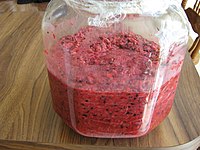
An efficient method for improving the stability of Monascus pigments using ionic gelation.
Sign Up to like & getrecommendations! Published in 2023 at "Journal of the science of food and agriculture"
DOI: 10.1002/jsfa.12685
Abstract: BACKGROUND Monascus pigments (Mps) are easily impacted by heating, pH and light, resulting in the degradation. In this study, Mps were encapsulated by ionic gelation method with sodium alginate (SA) and sodium caseinate (SC) as… read more here.
Keywords: encapsulated mps; ionic gelation; method; stability ... See more keywords

Production of Monascus pigments as extracellular crystals by cell suspension culture
Sign Up to like & getrecommendations! Published in 2017 at "Applied Microbiology and Biotechnology"
DOI: 10.1007/s00253-017-8646-1
Abstract: It is generally accepted that Monascus pigments are predominantly cell-bound, including both intracellular and surface-bound pigments. This long-term misconception was corrected in the present work. Production of extracellular crystal pigments by submerged culture of Monascus… read more here.
Keywords: suspension culture; monascus pigments; cell suspension; monascus ... See more keywords

Sulfonation of Monascus pigments to produce water-soluble yellow pigments
Sign Up to like & getrecommendations! Published in 2020 at "Dyes and Pigments"
DOI: 10.1016/j.dyepig.2019.107965
Abstract: Abstract Red Yeast Rice, a kind of Monascus pigments produced by fermentation of Monascus species on rice, is a traditional Chinese medicine and food colorant. Chemical modification of natural pigments is a common strategy to… read more here.
Keywords: monascus pigments; water soluble; sulfonation monascus; monascus ... See more keywords

Highly Efficient Production of Tailored Monascus Pigments by Using a Biocompatible Chemical Reaction Interfacing with Microbial Metabolism
Sign Up to like & getrecommendations! Published in 2021 at "ACS Sustainable Chemistry & Engineering"
DOI: 10.1021/acssuschemeng.0c09422
Abstract: A biocompatible reaction interfacing with microbial metabolism is an efficient approach for production of desired chemicals. Monascus pigments are a traditional natural food colorant from a microbi... read more here.
Keywords: interfacing microbial; reaction interfacing; monascus pigments; microbial metabolism ... See more keywords

Separation of Monascus pigments from extractive fermentation broth with a high concentration of triton X-100
Sign Up to like & getrecommendations! Published in 2018 at "Separation Science and Technology"
DOI: 10.1080/01496395.2018.1461906
Abstract: ABSTRACT In this study, Monascus pigments were separated from the extractive fermentation broth by the combination of reverse micellar extraction and macroporous resins (MACR) adsorption with the alkalizing S-8 MACR (S-8 ALR). A 95.07% pigment… read more here.
Keywords: adsorption; monascus pigments; triton 100; extractive fermentation ... See more keywords

Diversifying of Chemical Structure of Native Monascus Pigments
Sign Up to like & getrecommendations! Published in 2018 at "Frontiers in Microbiology"
DOI: 10.3389/fmicb.2018.03143
Abstract: Red Yeast Rice, produced by solid state fermentation of Monascus species on rice, is a traditional food additive and traditional Chinese medicine. With the introduction of modern microbiology and biotechnology to the traditional edible filamentous… read more here.
Keywords: monascus species; monascus pigments; native monascus; monascus ... See more keywords

NaCl Inhibits Citrinin and Stimulates Monascus Pigments and Monacolin K Production
Sign Up to like & getrecommendations! Published in 2019 at "Toxins"
DOI: 10.3390/toxins11020118
Abstract: Applications of beneficial secondary metabolites produced by Monascus purpureus (M. purpureus) could be greatly limited for citrinin, a kidney toxin. The link of NaCl with cell growth and secondary metabolites in M. purpureus was analyzed… read more here.
Keywords: monascus pigments; nacl; cell growth; pigments monacolin ... See more keywords